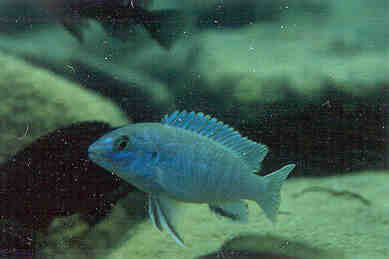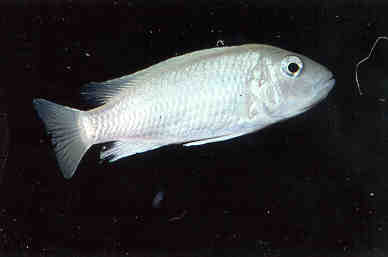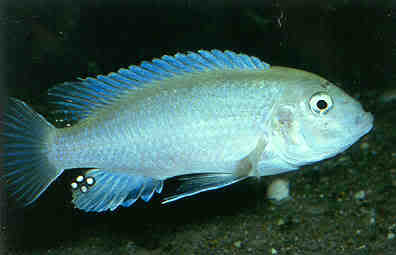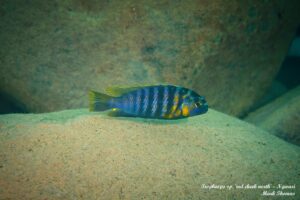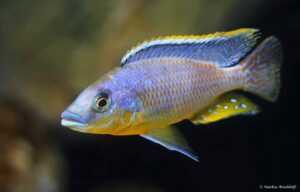Labidochromis pallidus
Labidochromis pallidus was first described by D.S.C. Lewis in 1982. The genus name can be broken into two parts. Labido-: This comes from the Greek word “labis,” meaning “pincers,” referring to the pincer-like forward teeth of this genus. Chromis: This is a name dating back to Aristotle and possibly derived from “chroemo” (neighen), referring to a drum (Sciaenidae) and the fish’s ability to make sound. Later, this name was expanded to include cichlids, damsels and wrasses, all bass-like fish once considered related. The species name “pallidus” is Latin for “pale” or “sallow white.” This refers to the striking light coloration of the fish.
In the trade, they are sometimes referred to as “Labidochromis Fryeri”
Synonym: Labidochromis margaritae
Description
Labidochromis pallidus has a laterally strongly flattened body, with a pointed head and a small mouth. The basic color is sallow white, sometimes with a blue-purple tinge on the flanks. There are no specific patterns or markings. The fins are generally pale, with possibly a dark edge in dominant males on the anal fin and pelvic fins. Maximum length is about eight centimeters, with females remaining slightly smaller than males. They closely resemble Labidochromis mylodon.
Sexual differences: Sex distinction is less pronounced than in many other Mbuna cichlids. Dominant males exhibit a more intense blue-purple color, especially on the anal fin and pelvic fins, which may have a dark edge. Females are generally less colorful and remain smaller. The size and number of “egg spots” in the anal fin can be an indication of sex: males tend to have larger and more egg spots. Behavioral differences are mainly related to territorial behavior, which is stronger in males.
Behavior and Temperament: Labidochromis pallidus is an agile swimmer with territorial behavior, especially in males. Males are relatively tolerant among themselves. They live in groups, but exhibit territorial behavior, especially males. They are rock dwellers and live in shallow, rocky areas of Lake Malawi.
Biotope
Labidochromis pallidus is found in nature only in Malawi. The fish live in Lake Malawi and are found near the three Maleri islands (Maleri, Nakantenga and Nankoma), as well as Thumbi West Island. Lewis suspects that the population at the latter site is a remnant of animals dumped there by former exporter Peter Davies.
Their natural habitat consists of shallow, rocky areas of the lake, to a depth of about 5 meters. The bottom consists of rocks. Due to the length and depth of Lake Malawi, water conditions and temperature are fairly constant throughout the year.
Diet
In their natural habitat, Labidochromis pallidus feeds mainly on loose Aufwuchs (algae and other organisms on rock surfaces) and insect larvae.
In an aquarium, a varied diet of both green food and insect larvae is suitable. Examples of suitable food include Daphnia, Artemia, Mysis, mosquito larvae and dry food. A varied diet is important to ensure good fish health and growth.
The Aquarium
For a male with one or more females Labidochromis pallidus, an aquarium at least 100 centimeters in length is recommended. For multiple pairs, a considerably larger aquarium is needed, at least 120 centimeters per pair, to provide adequate space and hiding places and minimize aggression.
The aquarium should have a rocky layout with adequate burrows and hiding places, although they do not use them as much as other rock dwellers. Plants are not necessary, but can be added as additional decoration and shelter. A sandy bottom is most suitable; fine gravel can also be used, but make sure there are no sharp edges that could injure the fish.
The ideal water values for Labidochromis pallidus are a pH of 7.5 to 8.5, a total hardness (°dH) above 10 and a temperature of 22-26°C.
Labidochromis pallidus can be kept well with other rock-dwelling Mbuna cichlids, such as Melanochromis auratus, Maylandia lombardoi, and Cynotilapia afra, provided there is sufficient space and hiding places. It is not recommended to keep them together with fish that prefer a different habitat or that are too large or aggressive.
Breeding aquarium and conditioning
The breeding of Labidochromis pallidus does not require a special breeding aquarium. They can simply be bred in a mixed aquarium. However, be sure to provide plenty of hiding places among the rocks where the females can take refuge once they have their maws full of eggs.
The spawn
As soon as a male notices that a female is ready to spawn, he chooses a spot in the sand. With trembling movements, he swims in front of the female. He puts on his fins and shows his most beautiful colors. When the female is ready, she follows the man to his chosen spot to spawn.
Above the sand, the pair of Labidochromis pallidus circle each other. The female lays one or a few eggs in the sand. In the spin, the male fertilizes the eggs. The female turns around and picks up the eggs and takes them into her maw. This process repeats itself until all the eggs are laid and they are in the female’s maw. The male’s job is now done. The female hides among the rocks to incubate the eggs.
Raising the Labidochromis pallidus fry
The eggs hatch in the female’s maw after a few days. They do not leave the female’s maw yet. They continue to feed on their egg yolk sac and grow for some time. Only about three weeks after depositing, the female releases the young fish among the rocks. They must now fend for themselves.
In an aquarium with other adult Malawi cichlids, the young fish are often eaten quickly. If you want to breed larger numbers, catch the female from the main aquarium after about 17 days. Place her in a rearing aquarium. Furnish this with some sand on the bottom and a hiding place where she can hide. The female will release the young fish after about three weeks from the time they are deposited. She will not eat the young fish for the first few hours. You have plenty of time to place the female back in the main aquarium.
Peculiarities about Labidochromis pallidus
The information reveals the following additional details:
- Geographic limitation: Labidochromis pallidus has a very limited geographic distribution within Lake Malawi. The species is known only from the three Maleri Islands (Maleri, Nakantenga and Nankoma) and Thumbi West Island. The population on Thumbi West Island may have come from animals dumped there, although this is disputed.
- Color variation: Although the basic color is sallow white, a bluish-purple tinge may occur on the flanks, especially in dominant males. The anal fin and pelvic fins may show a dark edge.
- Sex differentiation: Sex differentiation is subtle, less pronounced than in many other Mbuna cichlids. The size and number of “egg spots” (ovospots) in the anal fin can be an indication of sex.
- Habitat Preference: The fish live in shallow, rocky areas of the lake, to a depth of about 5 meters. They use shelters less than other rock dwellers.
- Aquarium trade: The species can be found in the aquarium trade, but the origin of these fish may be illegal, as the capture and export of these fish from Lake Malawi National Park is prohibited.
- Taxonomic uncertainty: The original description of the species by Lewis in 1982 was based on a type series that included multiple species. The holotype of L. textilis, a synonym that is no longer used, is a large specimen with specific features of the jaw and teeth.
- Comparison to other species: Labidochromis pallidus is compared to other white Labidochromis species, such as L. caeruleus, L. mylodon, and L. chisumulae, which can also develop a bluish-purple coloration in reproductively active males. The bicuspid dentition (two-tipped teeth) is a primitive feature preserved in this species.
- Rarity: The species is relatively unknown in the aquarium hobby.
Conclusion
Labidochromis pallidus is a relatively unknown Mbuna cichlid with a limited distribution in Lake Malawi. The species is distinguished by its pale, almost white coloration, with a possible blue-purple tinge. Gender distinction is subtle, and they exhibit relatively tolerant territorial behavior. In an aquarium, rocky furnishings with adequate hiding places are important, as are stable water parameters. A varied diet of greens and insect larvae is recommended. Breeding is possible, but requires sufficient hiding places for the mouthbrooding females. The most striking feature is their striking pale color, unlike many other colorful Mbuna cichlids.
Video
Authors
Walter Deproost – John de Lange
Copyright images
Walter Deproost
References
A revision of the genus Labidochromis (Teleostei: Cichlidae) from Lake Malawi”, Zool. J. Linn. Soc. 75: pp. 235-238 .
